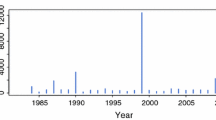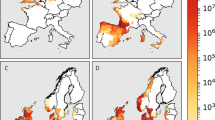Abstract
High winds are one of the nation’s leading damage-producing storm conditions. They do not include winds from tornadoes, winter storms, nor hurricanes, but are strong winds generated by deep low pressure centers, by thunderstorms, or by air flow over mountain ranges. The annual average property and crop losses in the United States from windstorms are $379 million and windstorms during 1959–1997 caused an average of 11 deaths each year. Windstorms range in size from a few hundred to hundreds of thousands square kilometers, being largest in the western United States where 40% of all storms exceed 135,000 km2. In the eastern United States, windstorms occur at a given location, on average, 1.4 times a year, whereas in the western US point averages are 1.9. Midwestern states average between 15 and 20 wind storms annually; states in the east average between 10 and 25 storms per year; and West Coast states average 27–30 storms annually. Storms causing insured property losses >$1 million, labeled catastrophes, during 1952–2006 totaled 176, an annual average of 3.2. Catastrophic windstorm losses were highest in the West and Northwest climate regions, the only form of severe weather in the United States with maximum losses on the West Coast. Most western storms occurred in the winter, a result of Pacific lows, and California has had 31 windstorm catastrophes, more than any other state. The national temporal distribution of catastrophic windstorms during 1952–2006 has a flat trend, but their losses display a distinct upward trend with time, peaking during 1996–2006.






Similar content being viewed by others
References
Changnon SA (1967) A method for evaluating substation records of hail and thunderstorms. Mon Weather Rev 95:209–212
Changnon SA (1980) Climatology of high damaging wind in Illinois. Report of investigation 95. Illinois State Water Survey, Champaign, IL
Changnon SA, Changnon D (1992) Storm catastrophes in the US. Nat Hazards 2:612–616
Changnon SA, Hewings J (2001) Losses from weather extremes in the United States. Nat Hazards Rev 2:113–123
Lecomte E (1993) Remarks: climate and the insurance industry: the next generation. College of Insurance, New York, pp 13–19
National Research Council (1999) The costs of natural disasters: a framework for assessment. National Academy of Science, Washington, DC, p 56
Property Claims Service (2007) The catastrophe record for 2006. The fact book 2006: property casualty insurance. Insurance Information Institute, New York
Rauber RM, Walsh JE, Charlevoix DJ (2002) Severe and hazardous weather. Kendall/Hunt Pub. Co., Dubuque, IA
Roth RJ (1996) The property casualty insurance industry and the weather of 1991–1994. Impacts and responses of the weather insurance industry to recent weather extremes. Changnon Climatologist, Mahomet, IL, pp 101–132
Storm Data (1997) National climatic data center, NOAA, vol 1–39
Storm Data (2009) National climatic data center, NOAA, vol 37–51
Author information
Authors and Affiliations
Corresponding author
Rights and permissions
About this article
Cite this article
Changnon, S.A. Windstorms in the United States. Nat Hazards 59, 1175–1187 (2011). https://doi.org/10.1007/s11069-011-9828-2
Received:
Accepted:
Published:
Issue Date:
DOI: https://doi.org/10.1007/s11069-011-9828-2




